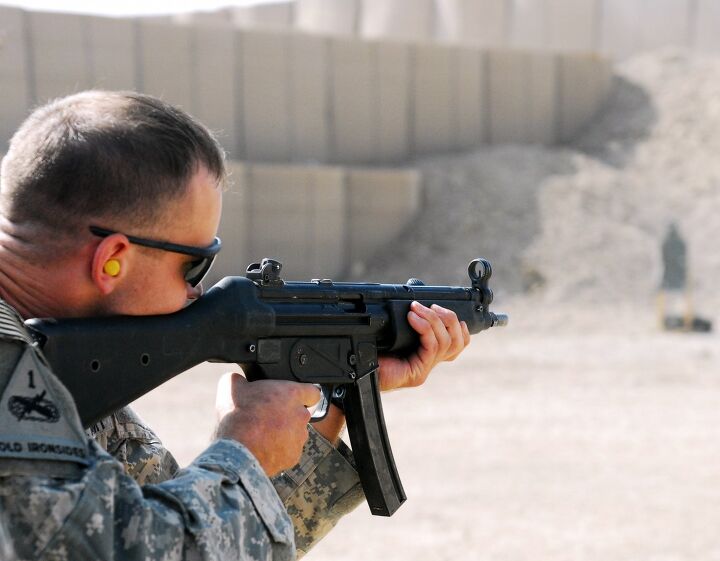We have been closely following the developments of the US Army’s new Sub Compact Weapon Program since the release of an extremely broad Request For Information back in May. With the recent award of no less than 13 sole source evaluation contracts for submachine guns its time we broke down the entries. In this two-part series, we’ll look at the entries.
Historically, the US Army has spent the last 50 years moving away from submachine guns, declining to replace the M3 Grease Gun in the mid-1950s, instead adopting the lightweight assault rifle concept. Submachine guns like the HK MP5 have been used in niche roles but there has been little interest in adopting a new design, until now.
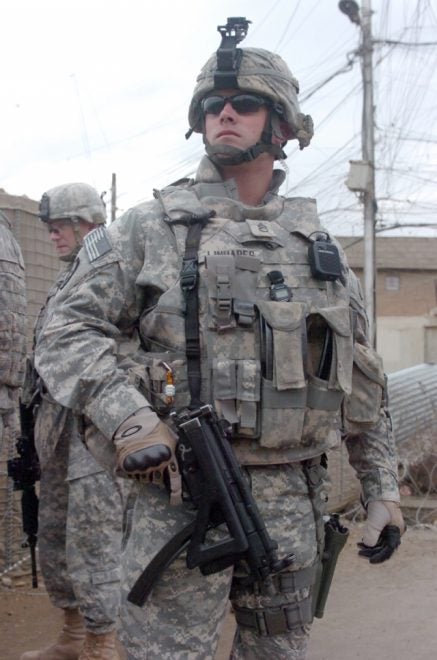
Staff Sgt. Shawn P. Linhares [with an MP5K], a Sierra Vista, Arizona native, 25th Infantry Division, surveys his surroundings as he and his fellow Soldiers escort Iraqi Army Officials and 25th Infantry Division leadership through the streets of Mosul, Iraq Dec. 2008. (Pvt. 1st Class Jesus J. Aranda/US Army)
What Is A Personal Security Detail?
To understand why the Sub Compact Weapon is needed we have to understand the role of Personal Security Details. The primary purpose of a PSD is to protect a ‘Principal’, principals can be senior officers and command staffs, visiting dignitaries and other high-risk assets. Typically PSDs employed in force protection are made up a number of teams including advanced parties and protective and quick reaction teams. They are responsible for the safety of their principals while on the move and at various locations they visit in volatile areas. This means that PSD personnel are frequently in and out vehicles and operating in confined spaces.
PSDs also have to take their operating environments into consideration and what potential threats might look like. Typically PSD personnel have been armed with standard service weapons like the M9 Beretta and the M4 Carbine but the US Army Contracting Command’s recent RFI suggests that the M4 is not compact or concealable enough and the M9, and future M17/M18, does not offer the necessary firepower. This has lead to the requirement for a new Sub Compact Weapon that is select-fire, chambered in 9x19mm and can be concealed and easily transported.
The Contenders
The weapons the US Army has decided to evaluate vary greatly. The total spent on weapons for the SCW evaluations so far is estimated to be around $258,240. The value of the awards varies from as little as $8,500 to as much as $39,060. Additionally, it remains unclear what quantity of firearms have been ordered from each manufacturer.
Firstly, let’s break the contenders down based broadly on their operating systems and configurations. AR-pattern submachine guns are by far the largest category of submissions. These have the advantage of a familiar manual of arms, however, they typically have the drawback of being hampered by the AR’s buffer tube and non-folding stock. As such it is no surprise that Colt have entered the CM9MM-9H-M5A or Colt Modular 9mm Sub Compact Weapon. Colt have a long history of manufacturing AR-pattern submachine guns dating back into the 1980s. Unlike more recent AR-type pistol calibre carbines Colt’s offerings have typically used a magazine insert to allow the use of Uzi-pattern magazines.
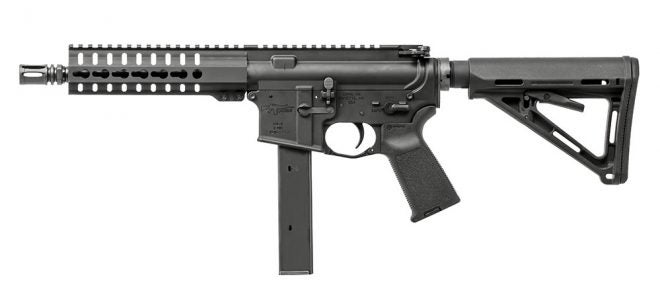
CMMG Mk9 PDW (CMMG)
Missouri-based CMMG, Inc. has submitted the ‘CMMG Ultra PDW Sub Compact Weapon’ probably a select-fire version of their Mk9 PDW, a weapon very similar to Colt’s submachine gun. CMMG, however, also sell the 9mm Guard range of pistol calibre carbines which feed from Glock magazines. CMMG’s contract is the smallest of all of the submissions at just $8,000.
Lewis Machine & Tool Company is submitting the intriguingly named ‘MARS-L9 Compact Suppressed Weapon’. This suggests that their entry is integrally suppressed, perhaps the only entry that is, and a direct response to the original RFI’s request for suppressor mounting capability. The MARS-L9 is probably a modified and rechambered version of LMT’s 5.56x45mm Modular Ambidextrous Rifle, which has been adopted by New Zealand. LMT’s website currently lists no carbines or PDW’s chambered in 9x19mm so this is new ground for the Illinois-based company.
Arizona-based Quarter Circle 10 describe themselves as the ‘industry resource for Pistol Caliber Carbine products’ and have submitted two weapons for testing the 5.5 CLT and 5.5 QV5. They have designs which feed from Colt, MP5, and Glock magazines. The CLT is not listed on their site but the QV5, which feeds from MP5 magazines, is. 5.5 is likely a reference to the submitted weapons’ barrel length. Quarter Circle 10’s contract award is worth $24,070.

Quarter Circle 10 5.5 QV5 (Quarter Circle 10)
The Angstadt Arms Corporation and Noveske Rifleworks were two of the three companies added, on 16th June, to the original 10 listed. The Oregon-based Noveske company was founded by John Noveske in the early 2000s, primarily as a barrel maker but has since grown to offer a range of ARs, but none chambered in 9mm, at least until now.
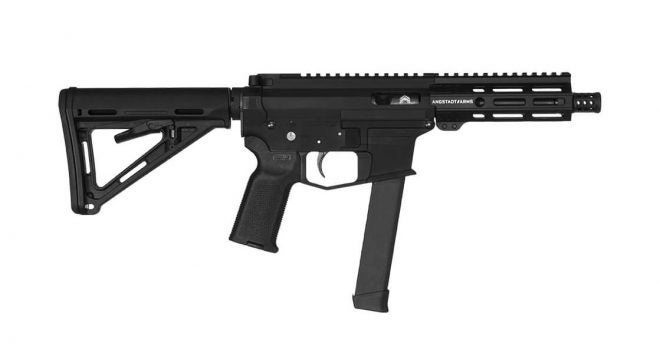
Angstadt Arms Corporation’s UDP-9 (Angstadt)
Angstadt, however, specialise in lightweight pistol calibre carbines and have a offered the SCW trials their UDP-9. The UDP-9 feeds from Glock magazines, uses Magpul furniture and is just 24 inches long. The North Carolina company has a $15,950 contract award to submit guns for testing.
The B&T Designs
B&T AG, formally Brügger & Thomet, are a Swiss small arms manufacturer who specialise in developing firearms – including a substantial catalogue of pistol calibre carbines and submachine guns including the MP9, USW, ACP series and GHM9. While B&T have no entered the SCW competition directly two companies are submitting B&T designs.
Trident Rifles, LLC is a ‘Service-Disabled Veteran-Owned Small Business providing global support and services to the US Federal Government’ according to their, largely empty, website. Based in Maryland they have been active since at least 2014, winning a series of contracts to supply US government agencies, including SOCOM and the Bureau Of Prisons, various small arms including 9mm pistols and 120mm mortar tubes. Trident Rifles handle all of B&Ts US Federal, government and military business and post dealer samples for the Swiss small arms manufacturer, offering the highly compact MP9. The MP9 is based on the Steyr TMP and is just 11.8 inches long with its stock collapsed – by far the shortest entry. Trident Rifles were awarded $36,000 to supply MP9s for testing.
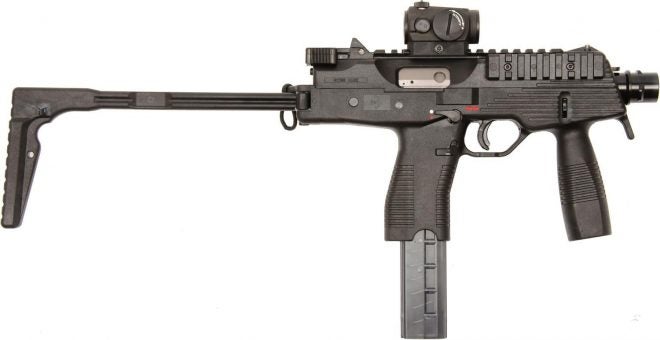
B&T MP9 compact machine pistol (B&T)
Beretta has submitted their new PMX submachine gun, originally developed for the Carabinieri, Italy’s national gendarmerie, the PMX is based on a B&T design. The PMX is based on the semi-automatic B&T P26 which Beretta has made a number of changes to including ambidextrous charging a more robust folding stock and a redesigned selector. The SCW submission is being handled by Beretta USA and the evaluations gun contract is worth $16,000. At 16.5 inches the PMX is certainly compact but not as compact as the MP9.
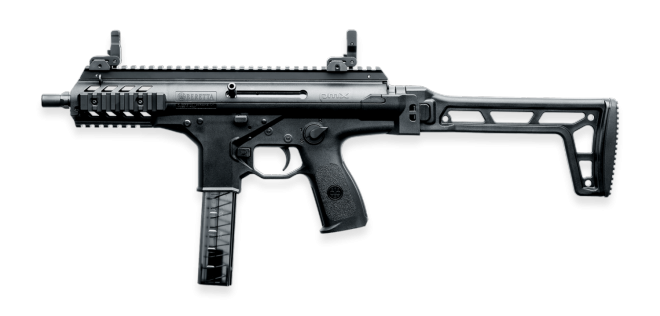
Left-side view of the Beretta PMX with stock extended (Beretta Defense Technologies)
In the next part, we will look at the rest of the SCW program entries including the MP5 clones that have been submitted as well as Heckler & Koch’s entry and the two favourites, the SIG MPX and the CZ Scorpion. We’ll also try to answer the important question of ‘why not 5.56 or .300BLK’?
 Your Privacy Choices
Your Privacy Choices
